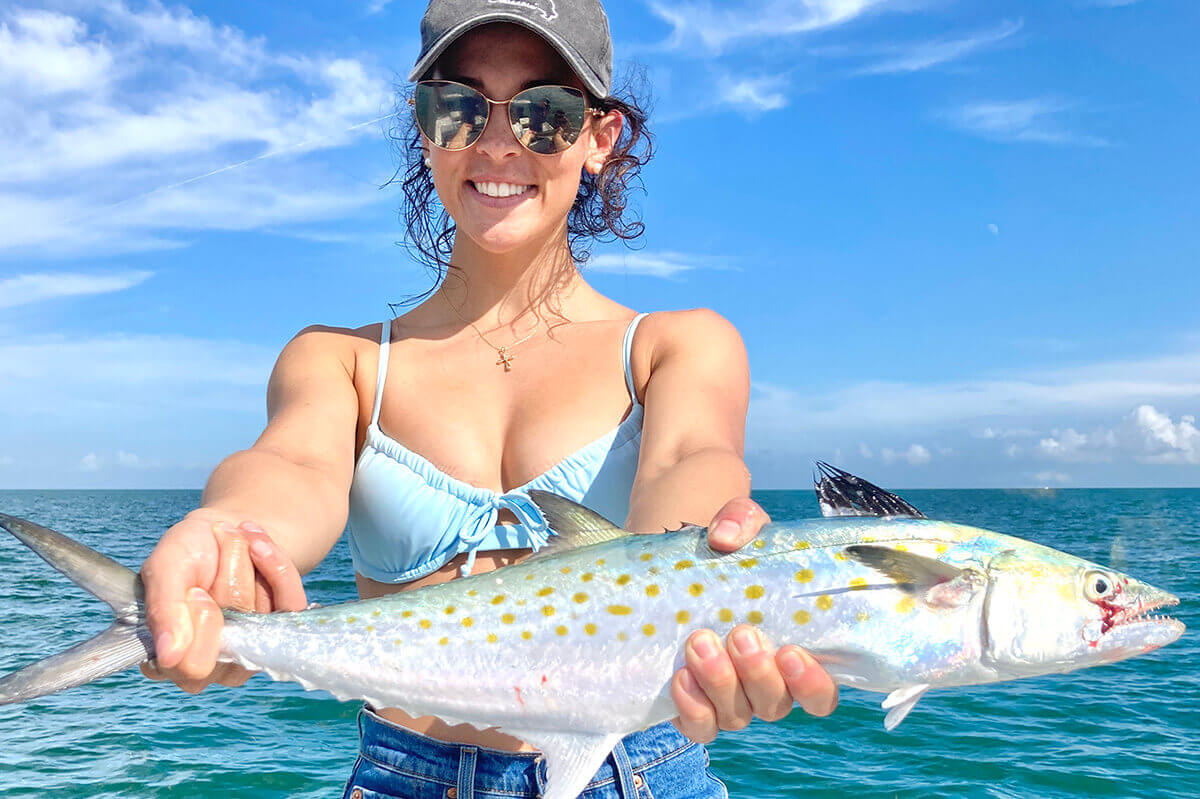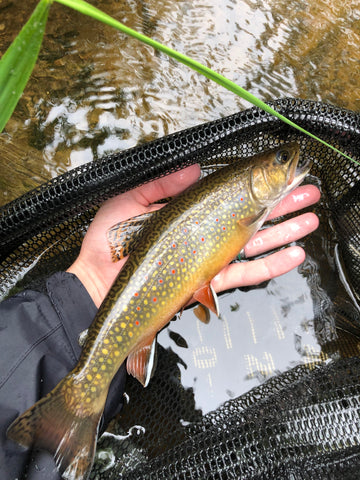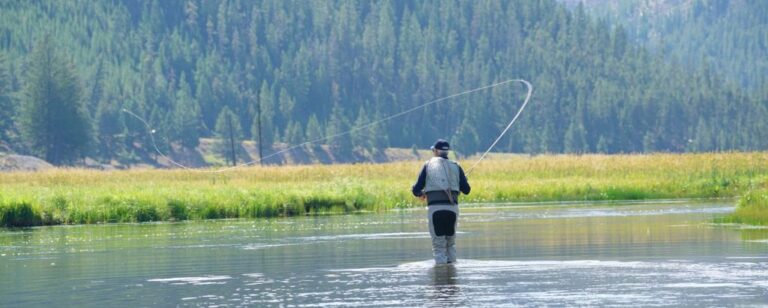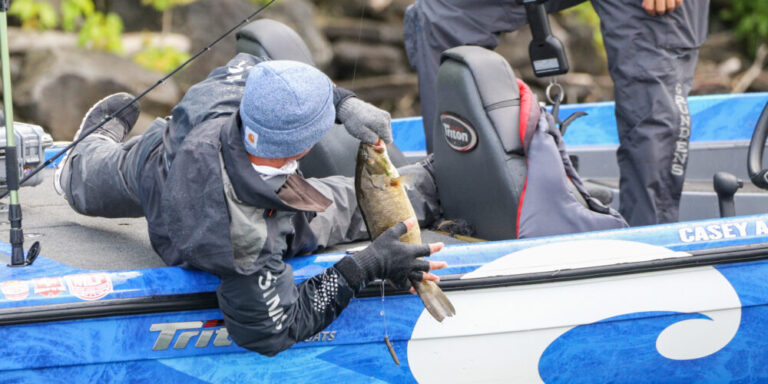Power fishing is a technique characterized by aggressive and fast-paced fishing styles that aim to cover large areas of water quickly. Power fishermen use lures that generate a lot of action and noise to entice fish into biting.
This technique is especially effective when targeting active and aggressive fish species, such as bass, pike, and muskie. Power fishing allows anglers to rapidly explore different areas and depths, increasing their chances of locating and catching fish. Its success relies on precision casting, retrieving techniques, and the ability to adapt to changing conditions on the water.
Whether using spinnerbaits, crankbaits, or topwater lures, power fishing can be a thrilling and productive approach for anglers seeking quality catches in a shorter amount of time.

Credit: www.floridasportsman.com
Introduction To Power Fishing
Fishing techniques have evolved over time, and one approach that has gained popularity among anglers is power fishing. The concept of power fishing revolves around fishing techniques that are swift, aggressive, and designed to cover a large area in a short span of time.
In this section, we will delve into the definition of power fishing, the importance of this approach in fishing techniques, how it differs from other fishing methods, and provide an overview of the article content.
Definition Of Power Fishing
Power fishing can be defined as an active and dynamic fishing method that involves using lures or baits that allow you to cover a lot of water quickly. This technique relies on speed, repetitive casting, and continuous retrieval to entice fish into striking.
It’s all about finding active feeding fish and triggering a reaction bite rather than waiting for fish to come to you.
Key points:
- Involves using lures or baits that cover a large area of water quickly.
- Relies on speed, repetitive casting, and continuous retrieval of the lure.
- Focuses on triggering a reaction bite from actively feeding fish.
Importance Of Power Fishing In Fishing Techniques
Power fishing plays a crucial role in fishing techniques, especially in situations where time is limited or when fish are actively feeding. This approach enables anglers to efficiently explore a vast area of water, increasing their chances of locating fish and enticing them to bite.
Here are the key reasons why power fishing is important:
Key points:
- Allows anglers to cover more water in a short amount of time, maximizing their chances of finding fish.
- Ideal for targeting aggressive fish species or when fish are actively feeding.
- Enables anglers to quickly eliminate unproductive areas to focus on more promising spots.
How Power Fishing Differs From Other Fishing Methods
Power fishing stands apart from other traditional fishing methods in terms of technique and equipment used. While conventional methods such as finesse fishing involve a slower and more delicate approach, power fishing represents a more aggressive and active style of fishing.
Here’s how it differs from other fishing methods:
Key points:
- In power fishing, the emphasis is on quick and repetitive casting to cover a larger area, whereas finesse fishing involves meticulous presentations and subtle movements.
- Power fishing employs heavier tackle, such as larger rods and reels, to handle larger lures and cover more water.
- Unlike finesse fishing, power fishing relies on triggering a reaction bite rather than enticing a fish to bite out of hunger or curiosity.
Overview Of The Article Content
We will explore the world of power fishing from various angles. We will discuss the different types of lures and baits commonly used in power fishing, delve into specific power fishing techniques, and provide tips to enhance your power fishing skills.
Additionally, we will share insights on when and where power fishing is most effective, and highlight success stories from anglers who have mastered this technique. So, whether you’re a beginner looking to learn about power fishing or an experienced angler seeking to refine your skills, this article will provide valuable knowledge to enhance your fishing experience.
Remember, power fishing is not just about speed and aggression; it requires finesse and understanding of your fishing environment. So, let’s dive into the world of power fishing and discover the excitement and rewards it has to offer.
Advantages Of Power Fishing
Power fishing is a popular technique among anglers that offers a range of advantages for those looking to maximize their fishing success. Whether you’re a seasoned pro or a novice fisherman, power fishing provides several benefits that can enhance your fishing experience.
From increased chances of catching more fish to the ability to cover large areas of water quickly, power fishing is a versatile and effective approach that is suitable for various fishing conditions and environments. This section will explore the advantages of power fishing in more detail.
Increased Chances Of Catching More Fish
Power fishing significantly increases your chances of catching more fish compared to other fishing techniques. The aggressive nature of power fishing allows you to entice bites from various fish species. By using fast and aggressive lure presentations, you create a sense of urgency, triggering a predatory response from fish.
This approach increases the likelihood of attracting bites, even in situations where fish may not be actively feeding. Power fishing focuses on covering a lot of water efficiently, enabling you to target fish more effectively and increase your catch rate.
Key advantages of power fishing for increased catch rates include:
- Efficiency: Power fishing allows you to cover a larger area of water in a shorter period, increasing your chances of encountering fish and hooking more bites.
- Versatility: This technique can be employed in various fishing scenarios, from freshwater to saltwater, and from rivers to lakes. It is suitable for targeting different species, including bass, pike, musky, and even saltwater gamefish.
- Aggressive presentations: Power fishing utilizes lures and techniques that mimic the prey fish’s behavior, emphasizing speed and action. This aggressive approach triggers a reflex response from predatory fish, enticing them to strike.
- Opportunity to explore: By covering vast stretches of water quickly, power fishing allows you to explore new fishing areas, searching for active fish and potential hotspots. This enables you to adapt to changing conditions and increases your chances of success.
Ability To Cover Large Areas Of Water Quickly
One of the key advantages of power fishing is its ability to cover large areas of water quickly. Unlike other techniques that may require a more patient and slow-paced approach, power fishing allows you to move rapidly between spots, maximizing your time on the water.
This technique is particularly effective when targeting fish that are actively on the move or in pursuit of prey.
Advantages of covering large areas of water quickly with power fishing include:
- Time-efficiency: Power fishing enables you to explore different sections of a body of water within a short period. This is especially beneficial when time is limited, and you want to make the most out of your fishing trip.
- Locating active fish: By rapidly moving through various areas, you can locate active fish more efficiently. If you’re not getting bites in one spot, you can quickly move and search for fish that are willing to strike.
- Covering diverse habitats: Power fishing allows you to target different habitats and structures, including points, weed edges, rock piles, and submerged timber. This gives you the opportunity to find where the fish are actively feeding or hiding.
- Adapting to changing conditions: By covering large areas quickly, you can adapt to changing environmental conditions, such as water temperature, wind direction, or light intensity. This flexibility increases your chances of finding fish in a variety of scenarios.
Suitable For Various Fishing Conditions And Environments
Power fishing is a versatile technique that can be applied in a wide range of fishing conditions and environments. From shallow water to deep structures, power fishing allows you to target fish effectively regardless of the fishing scenario. Whether you’re fishing in freshwater or saltwater, rivers or lakes, this technique can be tailored to suit the specific conditions and increase your chances of success.
Advantages of power fishing in various fishing conditions and environments include:
- Adaptability: Power fishing can be adapted to different styles and methods, such as crankbaiting, spinnerbaiting, or flipping and pitching. This versatility ensures that you can tackle various fishing scenarios and adjust your approach accordingly.
- Covering different water depths: Power fishing techniques can be employed in shallow or deep water, targeting both near-surface fish and those holding in deeper structures. This allows you to explore various zones and increase your chances of finding active fish.
- Wide range of species: Power fishing is effective for targeting a diverse range of fish species, including freshwater bass, walleye, northern pike, and saltwater species like striped bass or redfish. It provides an opportunity to catch different fish in different environments.
- Year-round applicability: Power fishing can be used throughout the year, adapting to seasonal changes and fishing conditions. Whether it’s spring, summer, fall, or winter, power fishing techniques can be modified to suit the prevailing circumstances, maximizing your fishing opportunities.
Power fishing offers several advantages that can enhance your fishing experience and increase your chances of success. By utilizing aggressive lures, covering large areas of water quickly, and being suitable for various fishing conditions, power fishing allows you to become a more efficient angler and catch more fish.
Embrace the power fishing technique, and enjoy the benefits it brings to your fishing adventures.
Techniques For Power Fishing Success
Power fishing is a technique that allows anglers to cover a large amount of water in a short period of time, targeting actively feeding fish. It involves using aggressive techniques and gear to entice fish into biting. Are you interested in mastering the art of power fishing?
In this section, we will explore the key techniques for power fishing success.
Selecting The Right Fishing Rod And Reel
To maximize your power fishing efforts, it is crucial to choose the appropriate fishing rod and reel that can handle the demands of this fast-paced fishing style. Consider the following key points:
- Opt for a medium to heavy action rod with a fast or extra fast tip for increased sensitivity and quicker hooksets.
- Choose a low-profile baitcasting reel for better control and accuracy during casting and retrieving.
- Look for a reel with a high gear ratio, such as 7: 1 or higher, to enable faster lure retrieval.
Choosing The Appropriate Line And Lure For Power Fishing
The line and lure selection plays a vital role in power fishing success. Here are some factors to keep in mind:
- Select a braided fishing line with a high pound test (20-40 lb) to handle heavier lures and provide better sensitivity for detecting subtle bites.
- Choose lures that create a lot of noise, vibration, or movement to grab the attention of active fish. Spinnerbaits, crankbaits, and topwater lures are popular choices for power fishing.
Casting Techniques For Optimal Lure Presentation
Proper casting techniques are essential for effectively presenting your lure to the fish. Consider the following tips:
- Master the art of the long-distance cast to cover a larger area of water and increase your chances of encountering feeding fish.
- Practice accuracy and precision by casting to specific targets, such as weed beds, submerged structures, or along the edges of drop-offs.
- Experiment with different casting angles and retrieves to discover what triggers the most strikes from active fish.
Retrieval Methods To Maximize Effectiveness
The way you retrieve your lure can make a significant difference in your power fishing success. Keep these points in mind:
- Utilize a fast and aggressive retrieve to mimic the movements of prey and trigger predatory instincts in actively feeding fish.
- Vary your retrieval speed and pause briefly to imitate injured or struggling baitfish, enticing fish to strike.
- Pay attention to how fish are responding and adjust your retrieval technique accordingly to maximize effectiveness.
Tips For Identifying Productive Fishing Spots
Power fishing is all about covering water quickly and efficiently. Here are some tips for identifying productive fishing spots:
- Look for areas with visible signs of fish activity, such as jumping fish, baitfish schools, or surface disturbances.
- Target areas with cover and structure, such as weed beds, docks, fallen trees, or submerged rocks, as they often provide shelter and food for fish.
- Pay attention to water temperature, wind direction, and current flow, as these can all influence fish behavior and feeding patterns.
Mastering the techniques for power fishing success takes practice, patience, and a deep understanding of the fish species you’re targeting. By selecting the right gear, choosing the appropriate line and lure, using effective casting and retrieval techniques, and identifying productive fishing spots, you’ll increase your chances of hooking into more fish during your power fishing expeditions.
So gear up and get ready to unleash the power of your fishing skills on the water!
Technique 1: Fast And Furious
Overview Of The Fast And Furious Power Fishing Technique
When it comes to power fishing, one technique that stands out is the fast and furious approach. This technique involves using crankbaits and spinnerbaits to mimic the movement of prey, attracting aggressive fish and enticing them to strike. By casting and retrieving at high speeds, anglers can cover a large area of water quickly, increasing their chances of success.
In this section, we’ll explore the key points of the fast and furious power fishing technique, including techniques for casting and retrieving at high speeds, as well as tips for varying depths and locations.
Using Crankbaits And Spinnerbaits To Mimic Prey Movement
- Crankbaits and spinnerbaits are highly effective lures for power fishing due to their ability to imitate the movement of baitfish and other prey.
- Crankbaits are designed to dive underwater and create a realistic wobbling action, while spinnerbaits have spinning blades that produce flashes and vibrations to attract fish.
- The lifelike swimming action of these lures triggers the predatory instincts of fish, making them more likely to strike.
Techniques For Casting And Retrieving At High Speeds
- When power fishing with crankbaits and spinnerbaits, casting and retrieving at high speeds is crucial to cover a large area and trigger reaction bites.
- Use an overhead casting technique to generate distance and accuracy when casting.
- Start reeling as soon as the lure hits the water to maintain a steady retrieve.
- Experiment with different retrieval speeds to find the most effective one for the given conditions.
- Add occasional twitches or pauses during the retrieve to make the bait look more erratic, mimicking the behavior of injured prey.
Tips For Varying Depths And Locations
- To increase your chances of success, it’s essential to vary the depths and locations where you fish.
- Target areas with structure, such as submerged rocks, fallen trees, and weed beds, as they attract both prey and predator fish.
- Make casts parallel to structure or cover, allowing the lure to run close to it, increasing the chances of triggering a strike.
- Explore different areas of the water column by adjusting the retrieve speed or using lures with different diving or sinking depths.
- Pay attention to any signals in the water that may indicate the presence of fish, such as baitfish activity, bird activity, or fish surface activity.
Remember, the fast and furious power fishing technique is all about covering water quickly and enticing aggressive fish to strike. By using crankbaits and spinnerbaits to mimic prey movement, casting and retrieving at high speeds, and varying depths and locations, you can increase your chances of landing a trophy catch.
So, gear up, get out on the water, and give this power fishing technique a try!
Technique 2: Punching And Flippin’
Are you ready to learn a power fishing technique that will help you navigate heavy cover and increase your chances of landing that trophy fish? Look no further than punching and flippin’. This technique involves presenting baits directly into dense vegetation and structure, enticing even the most elusive fish to strike.
In this section, we will explore the key elements of punching and flippin’, including equipment selection, flipping techniques, and tips for presenting baits in challenging environments. Let’s dive in!
Introduction To The Punching And Flippin’ Power Fishing Technique
Flipping and punching are highly effective methods for targeting fish hiding in heavy cover. Here are the key points to keep in mind:
- Flipping involves making short, accurate casts by letting the bait enter the water with minimal disturbance. This technique is ideal for close-quarters combat with fish in tight spots.
- Punching, on the other hand, requires a more forceful approach. Using specially designed weights, you’ll punch your bait through the cover, simulating a baitfish diving into the depths. This technique excels at triggering reaction strikes from lurking predators.
Selecting The Right Equipment For Heavy Cover Fishing
When it comes to fishing in heavy cover, having the appropriate gear is crucial. Here’s what you need:
- A heavy-action rod with a strong backbone to handle the weight and power necessary for punching and flipping.
- A low-profile baitcasting reel with a high gear ratio for quick line retrieval and ease of use.
- Braided line with a high pound test to ensure you can muscle fish out of cover without worrying about breaking off.
Techniques For Accurately Flipping Baits Into Cover
To effectively flip baits into cover, consider these pointers:
- Approach with stealth: Move quietly and avoid causing unnecessary disturbances to prevent spooking fish.
- Keep your bait high: Hold your rod tip high while positioning the bait near the water’s surface. This technique allows for better accuracy and control.
- Target specific areas: Focus on likely fish-holding spots such as submerged logs, brush piles, and overhanging vegetation.
Tips For Presenting Baits In Dense Vegetation And Structure
When dealing with dense vegetation and structure, follow these tips to enhance your chances of success:
- Use heavy sinkers: Opt for heavier weights to penetrate through thick cover and reach the fish hiding below.
- Texas rig your baits: Rigging your baits weedless with a texas rig helps prevent snagging.
- Vary your retrieve: Experiment with different retrieval speeds and pauses to trigger strikes from fish.
Remember, practice makes perfect! So, grab your gear, head to your favorite fishing spot, and start mastering the art of punching and flippin’. Good luck and tight lines!
Technique 3: Topwater Explosions
Overview Of The Topwater Explosions Power Fishing Technique
Looking to make a big splash on your next fishing adventure? Power fishing is a technique that allows you to cover a large area of water and entice aggressive bites. One particular technique within power fishing is known as topwater explosions.
This exhilarating technique involves using surface lures that create a commotion on the water’s surface, attracting fish to strike. Let’s dive into the key points of this exciting power fishing technique:
- Surface lures: Selecting the right topwater lures is crucial for generating explosive bites. Here are some popular options to consider:
- Popper lures: These lures are designed with a concave mouth, creating a popping sound and splashes that grab the attention of fish.
- Walk-the-dog lures: These lures have a zigzag action when retrieved, imitating a wounded baitfish and provoking strikes.
- Buzzbaits: These lures feature a metal blade that spins and creates vibrations and noise, imitating the movement of prey near the surface.
- Creating enticing presentations: Now that you have the right lures, it’s essential to use effective techniques to trigger strikes. Here are some tips for creating captivating topwater presentations:
- Vary your retrieve: Experiment with different speeds and pauses to imitate injured or fleeing prey.
- Make ripples: Before starting your retrieve, use your rod tip to create small ripples on the water’s surface, mimicking the disturbance caused by active prey.
- Target structure: Cast your lure near structures like fallen trees, docks, or weed beds where fish seek shelter and ambush prey.
- Targeting specific species: To maximize success, it’s important to adapt your techniques based on the species you’re targeting and the conditions you’re fishing in. Consider the following tips:
- Bass fishing: Bass are known for their aggressive topwater strikes. Use lures that imitate frogs, mice, or small fish to entice these predatory fish.
- Pike fishing: Pike are ambush predators that love to strike at surface lures. Opt for larger, more durable lures to withstand their sharp teeth.
- Morning and evening fishing: Fish tend to be more active near the surface during low light conditions. Focus your efforts during these times for better topwater action.
With the topwater explosions power fishing technique, you can experience heart-pounding strikes and an adrenaline rush like no other. So grab your gear, select the right lures, and get ready to make waves with your fishing skills. Happy angling!
Conclusion
Power fishing is a dynamic technique that has revolutionized the world of fishing. With its focus on efficiency and speed, power fishing allows anglers to cover more water in less time, increasing their chances of catching more fish. By using lures that create a commotion and provoke aggressive strikes, power fishing is effective in both shallow and deep waters.
This technique is not only limited to a specific time of year or fish species, making it versatile and accessible to all anglers. The success of power fishing lies in its ability to mimic natural prey and trigger a predatory response from fish.
Whether it’s flipping and pitching, swimbaits, or topwater lures, power fishing offers endless possibilities and excitement for anglers of all skill levels. So, if you’re looking to up your fishing game and maximize your chances of landing that trophy fish, give power fishing a try.
It’s time to take your angling skills to the next level and experience the thrill of power fishing.






